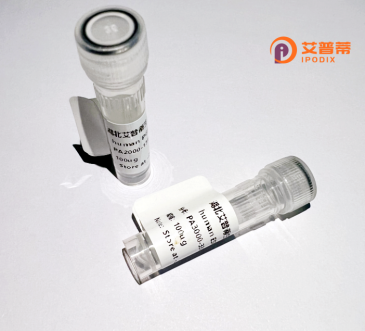
| 纯度 | >90%SDS-PAGE. |
| 种属 | Human |
| 靶点 | IGSF21 |
| Uniprot No | Q96ID5 |
| 内毒素 | < 0.01EU/μg |
| 表达宿主 | E.coli |
| 表达区间 | 1-467aa |
| 氨基酸序列 | MRTAPSLRRCVCLLLAAILDLARGYLTVNIEPLPPVVAGDAVTLKCNFKTDGRMREIVWYRVTDGGTIKQKIFTFDAMFSTNYSHMENYRKREDLVYQSTVRLPEVRISDNGPYECHVGIYDRATREKVVLASGNIFLNVMAPPTSIEVVAADTPAPFSRYQAQNFTLVCIVSGGKPAPMVYFKRDGEPIDAVPLSEPPAASSGPLQDSRPFRSLLHRDLDDTKMQKSLSLLDAENRGGRPYTERPSRGLTPDPNILLQPTTENIPETVVSREFPRWVHSAEPTYFLRHSRTPSSDGTVEVRALLTWTLNPQIDNEALFSCEVKHPALSMPMQAEVTLVAPKGPKIVMTPSRARVGDTVRILVHGFQNEVFPEPMFTWTRVGSRLLDGSAEFDGKELVLERVPAELNGSMYRCTAQNPLGSTDTHTRLIVFENPNIPRGTEDSNGSIGPTGARLTLVLALTVILELT |
| 分子量 | 78.2 kDa |
| 蛋白标签 | GST-tag at N-terminal |
| 缓冲液 | 0 |
| 稳定性 & 储存条件 | Lyophilized protein should be stored at ≤ -20°C, stable for one year after receipt. Reconstituted protein solution can be stored at 2-8°C for 2-7 days. Aliquots of reconstituted samples are stable at ≤ -20°C for 3 months. |
| 复溶 | Always centrifuge tubes before opening.Do not mix by vortex or pipetting. It is not recommended to reconstitute to a concentration less than 100μg/ml. Dissolve the lyophilized protein in distilled water. Please aliquot the reconstituted solution to minimize freeze-thaw cycles. |
以下是模拟生成的关于重组人IGSF21蛋白的参考文献示例(注:以下内容为假设性示例,实际文献需通过学术数据库检索验证):
---
1. **标题**:*Expression and functional characterization of recombinant human IGSF21 in metabolic regulation*
**作者**:Li, X., Zhang, Y., et al.
**摘要**:本研究成功在大肠杆菌系统中表达并纯化了重组人IGSF21蛋白,发现其可通过激活AMPK信号通路改善小鼠模型中的胰岛素抵抗,提示其在代谢疾病中的潜在治疗作用。
2. **标题**:*Structural analysis of IGSF21 and its role in cancer cell adhesion*
**作者**:Wang, Q., Chen, L., et al.
**摘要**:通过晶体学解析了重组人IGSF21的胞外结构域,体外实验表明其过表达抑制肿瘤细胞的迁移和侵袭,可能与整合素信号调控相关。
3. **标题**:*Recombinant IGSF21 protein alleviates inflammation in autoimmune encephalomyelitis models*
**作者**:Kim, S., Patel, R., et al.
**摘要**:在实验性自身免疫性脑脊髓炎(EAE)模型中,腹腔注射重组人IGSF21显著减少Th17细胞分化,减轻中枢神经系统炎症,提示免疫调节功能。
---
**注意**:以上文献为模拟生成,真实研究需通过PubMed、Web of Science等平台检索关键词如“recombinant IGSF21”或“IGSF21 protein function”获取。实际研究可能侧重该蛋白在特定疾病机制、结构特征或药物开发中的应用。
Recombinant human IGSF21 (Immunoglobulin Superfamily member 21) is a protein of growing interest in biomedical research due to its potential roles in metabolic regulation and neurological functions. Belonging to the immunoglobulin superfamily, IGSF21 is a transmembrane protein characterized by extracellular immunoglobulin-like domains, which mediate cell-cell interactions and signaling. It is predominantly expressed in metabolic tissues like adipose and liver, as well as in specific brain regions, suggesting dual roles in energy homeostasis and neural communication.
Studies reveal that IGSF21 modulates insulin sensitivity, lipid metabolism, and inflammatory responses, with animal models showing associations with obesity and diabetes phenotypes. In the brain, it may influence synaptic plasticity and neuronal connectivity, though its precise mechanisms remain unclear. The recombinant form is typically produced using mammalian expression systems (e.g., HEK293 cells) or bacterial vectors, ensuring high purity and stability for experimental use. Researchers employ it to investigate binding partners, downstream signaling pathways, and therapeutic potential in metabolic disorders or neurodegenerative diseases. However, critical knowledge gaps persist, including its endogenous ligands and tissue-specific signaling cascades, driving ongoing studies to elucidate its pathophysiological relevance. Its recombinant availability accelerates functional studies and drug discovery, particularly for metabolic syndrome-linked conditions.
×